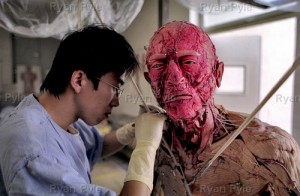 Body Worlds is presently on display in Salt Lake City here in the state where I live. In case you haven’t heard of this before, Body Worlds is described as part art, part science, the brainchild of Gunther von Hagens. It involves the use of actual cadavers whose tissues have been injected with plastic in order that they might be preserved and posed as an art display. In the case of the current exhibit in Salt Lake City, Body Worlds 3, the bodies are presented in a wide variety of athletic poses, from deceased skateboarding to basketball playing. The process of preservation is called “plastination”, and those functioning as art are referred to as “plastinates.”
Body Worlds is presently on display in Salt Lake City here in the state where I live. In case you haven’t heard of this before, Body Worlds is described as part art, part science, the brainchild of Gunther von Hagens. It involves the use of actual cadavers whose tissues have been injected with plastic in order that they might be preserved and posed as an art display. In the case of the current exhibit in Salt Lake City, Body Worlds 3, the bodies are presented in a wide variety of athletic poses, from deceased skateboarding to basketball playing. The process of preservation is called “plastination”, and those functioning as art are referred to as “plastinates.”
Throughout the history of modern medicine, human beings have been dissecting human bodies as a means of learning more about the body and how it functions. In order for medicine to progress this process has been necessary and important. It continues today as individuals donate their bodies for medical students and other scientists. But Body Worlds seems like something more than an activity facilitating the continuing advance of medical knowledge.
For me Body Worlds represents a curious and dark expression of the macabre in popular culture. In terms of it being a curiosity, on the one hand we often hear people decry violence in television and film, particularly in the horror genre, with its graphic depiction of bodily damage and mutilation. And yet the display of bodies carved into all kinds of configurations in the context of Body Worlds is considered a form of art which straddles both high and pop culture. On the other hand, as a dark expression of the macabre, I wonder why various cultures have made a value judgment against the Nazis for turning murdered Jews and other unwanted peoples into lampshades and other paraphernalia, and yet many people seem to laud the plastinates turned into poseable traveling displays as art. I understand that many of the deceased who are now Body Worlds art volunteered their bodies for use in this fashion, and thus they weren’t victims of genocide, but the question remains as to the ethical appropriateness of the use of human bodies for art or furniture. What view of human beings and sacralization related to human remains is attached to perceptions of the Body Worlds exhibit?
Another major ethical question looms in that allegations have been made that some of the bodies may come from executed prisoners in China, a country well known for human rights violations and questionable justice in speedy trials and immediate execution for a host of major and minor crimes. While von Hagens denies using such corpses in his exhibits at present, in 2004 he acknowledged such bodies were used which forced him to return them and stop the practice. Even so, news reports from this year indicate that questions remain concerning Chinese connections as the source for some the bodies.
Ultimately one’s views of the appropriateness or inappropriateness of Body Worlds and corpses as art comes down to a complex interplay between ethics related to cultural considerations. For my reflection on this phenomenon the images associated with the Frankenstein myth come to mind. (This is no doubt fueled by my forthcoming interview with Susan Tyler Hitchcock, author of Frankenstein: A Cultural History.) I envision Victor Frankenstein in his lab stitching together the pieces of cadavers in his own combination of science and art. The Frankenstein myth reminds us of the frequent human temptation to push beyond traditional boundaries of permissibility in relation to the body, science, and even art. The verdict of many readers and viewers of the various representations of the Frankenstein myth to such transgressions has been been a negative one. Is it applicable to Body Worlds? What does the use of bodies as art, whether those secured through ethical or unethical means, say about those cultures in which Body Worlds has been well received? Perhaps our sense of the Frankenstein story needs to be turned on its head: It was Victor Frankenstein who was the monster, not the creature he stitched together and brought to life. If this is so then it may be that our creation and enjoyment of plastinates reveals the monstrous in all of us.





There certainly is a line that shouldn’t be crossed and this is on the other side of that line.
Not everything that can be done should be simply because it can.
someone commented about this exhibit and said it is good education material for lower class countries filled with poverty where the exhibit will never be and that is because it is considered by its owners to be “expensive”